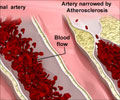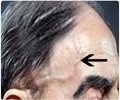The findings of a randomized, controlled clinical trial has revealed that one out of five patients with blockage in arteries that supply blood to the legs suffer silent coronary artery disease.
The findings of a randomized, controlled clinical trial has revealed that one out of five patients with blockage in arteries that supply blood to the legs and other parts of the body suffer silent coronary artery disease. Results were presented today at the annual meeting of the Radiological Society of North America (RSNA).
Peripheral arterial disease (PAD) occurs when plaque, a combination of fat, cholesterol and other substances, builds up in the arteries, limiting the flow of oxygen-rich blood throughout the body. PAD usually affects arteries that carry blood to the legs, causing poor circulation, discomfort and pain. More than eight million Americans have PAD, according to the American Heart Association.According to the National Heart, Lung and Blood Institute, coronary artery disease is the most common type of heart disease and the leading cause of death in the U.S.
"PAD patients, including those experiencing no symptoms of heart disease, are known to be at high risk for cardiovascular events such as a heart attack or stroke," said Rozemarijn Vliegenthart Proenca, M.D., Ph.D., radiology resident at the University Medical Center Groningen in the Netherlands. "The purpose of our clinical trial was to investigate whether noninvasive imaging of the heart and subsequent treatment of PAD patients result in a decrease in cardiac events compared to standard care."
In the clinical trial, a total of 231 PAD patients from four participating hospitals in the Netherlands were divided into one of two groups: one in which 108 patients received standard care—consisting of lifestyle changes and medication—for their condition, and a second group in which 115 patients underwent cardiac imaging of the heart in addition to standard care.
"With new, noninvasive cardiac imaging techniques, asymptomatic coronary atherosclerosis can be readily detected and treated," Dr. Vliegenthart Proenca said.
Among the 115 patients who received cardiac imaging, computed tomography (CT) revealed that 53, or 46 percent, had at least one significant narrowing of a coronary artery. Of those 53 patients, 22 had significant narrowing in the left main coronary artery or its equivalent, and were referred for treatment. Eight of those patients subsequently had bypass surgery, and three underwent coronary angiography with stent placement. The remaining patients were treated with medication.
Advertisement
In total, 24 (21 percent) of the 115 patients who underwent imaging had evidence of asymptomatic but severe coronary artery disease that required additional treatment.
Advertisement
Source-Eurekalert
SAV











